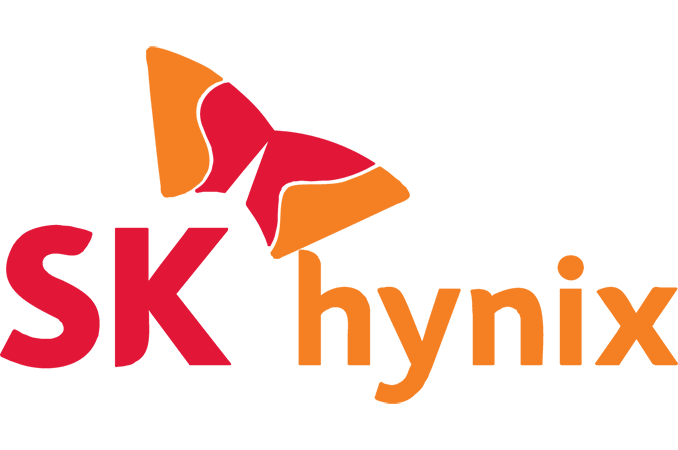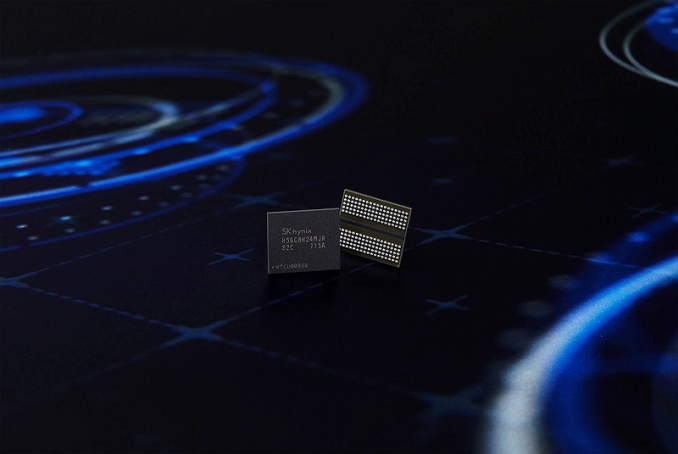SK Hynix Advances Graphics DRAM: GDDR6 Added to Catalogue, GDDR5 Gets Faster
by Anton Shilov on May 20, 2017 9:00 AM EST
SK Hynix has added GDDR6 memory chips to its product catalogue, revealing their general specifications and launch timeframe sometimes in Q4 2017. As expected, the new GDDR6 ICs will be available late this year and will run at speeds not achievable by GDDR5. GDDR5 is not really going away as SK Hynix has added several new SKUs into the catalogue, targeting forthcoming applications.
SK Hynix formally announced plans to produce GDDR6 in late April, so the addition of appropriate chips to the company’s databook does not really come as a surprise. The initial GDDR6 chips from SK Hynix will have an 8 Gb capacity and will feature 12 and 14 GT/s data transfer rates at 1.35 V. The new memory ICs will have a dual-channel 256Mx32 organization, which may indicate that GDDR6 chips will keep using 32-bit physical interface, but that I/O will operate as two 16-bit interfaces at all times to increase effective utilization of the bus (but this is a speculation at this point). The ICs will use 180-ball FCBGA packages and will thus be incompatible with existing GDDR5 and GDDR5X applications that use 170-ball and 190-ball form-factors, respectively.
| Specifications of SK Hynix's Upcoming 8 Gb GDDR6 and GDDR5 Memory Chips |
|||||||
| Part Number | Spec / FCBGA |
Data Rate | Bandwidth per Chip |
Voltage | Market | ||
| H56C8H24MJR-S2C | GDDR6 180-ball |
14 GT/s | 56 GB/s | 1.35V | Q4'17 | ||
| H56C8H24MJR-S0C | 12 GT/s | 48 GB/s | |||||
| H5GQ8H24AJR-R8C | GDDR5 170-ball |
10 GT/s | 40 GB/s | 1.55V | |||
| H5GQ8H24AJR-R6C | 9 GT/s | 36 GB/s | |||||
| H5GC8H24AJR-R2C | 8 GT/s | 32 GB/s | 1.50V | ||||
| 7 GT/s | 28 GB/s | 1.35V | |||||
| H5GC8H24AJR-R0C | 7 GT/s | 28 GB/s | 1.5V | ||||
| 6 GT/s | 24 GB/s | 1.35V | |||||
JEDEC yet has to finalize and publish specifications of GDDR6 and this is when we learn everything about peculiarities of the new memory. From SK Hynix we already know that the maximum planned data rate of the new memory will be 16 GT/s, implying a 16n prefetch and higher base clocks. We also know that one of the first graphics cards to use GDDR6 will have a 384-bit memory sub-system and assuming that it will run DRAM at 14 GT/s, it will feature 672 GB/s of bandwidth. Keep in mind that developers of GPUs and makers of graphics cards are rather conservative about memory frequencies, so, the final bandwidth could be lower, depending on yields of GPUs, DRAM ICs and graphics cards.
Besides GDDR6 memory, SK Hynix will also release 8 Gb GDDR5 chips rated for 9 and 10 GT/s data transfer rates at 1.55 V in Q4 2017. The new chips will target mass market applications that require higher memory bandwidth as well as cost efficiency of GDDR5, so, think of mainstream graphics cards. In addition to ultra high-speed GDDR5 devices, SK Hynix will also offer 7 and 8 GT/s GDDR5 chips with reduced voltages in the fourth quarter. The insertion of the new chips into the roadmap indicates that GDDR5 will remain on the market for at least a couple of years down the road and will celebrate a decade on the market next year.
| Specifications of SK Hynix's HBM2 Memory Chips | ||||||||
| Part Number | Density | Data Rate | Bandwidth per Stack |
Packaging | Feature | Availability | ||
| H5VR32ESM4H-12C | 4 GB | 1.6 GT/s | 204 GB/s | 5mKGSD | 4Hi stack, 1.2V | Q2'17 | ||
Speaking of graphics memory in general, it is also noteworthy that SK Hynix has removed mentions about HBM2 chips with 2 GT/s data rate from its product catalogue last quarter. As of now, the only HBM2 offering listed by the company are 4 GB 4Hi stacks with 1.6 GT/s data rate. The reasons for the move are unknown, but it is logical to assume that it is not easy to make very complex memory devices with a 512-bit I/O bus and high frequencies both from yields and from thermal points of view. Therefore, for products like AMD’s upcoming Radeon RX Vega, SK Hynix will have to offer HBM2 chips with 1.6 GT/s data rate and 204.8 GB/s bandwidth and it will be up to the buyers of such chips to implement further binning to higher frequencies.
Related Reading:
- SK Hynix to Ship GDDR6 Memory for Graphics Cards by Early 2018
- GeForce GTX 1080 Price Cut to $499; NVIDIA Partners To Begin Selling 10-Series Cards With Faster Memory
- Hot Chips 2016: Memory Vendors Discuss Ideas for Future Memory Tech - DDR5, Cheap HBM, & More
- Micron Confirms Mass Production of GDDR5X Memory
Source: SK Hynix











16 Comments
View All Comments
StevoLincolnite - Saturday, May 20, 2017 - link
Wonder what will be more price competitive, HBM2 or GDDR6? Both seem to hit around the 400-600GB/s barrier at the same capacity for GPU's.Yojimbo - Saturday, May 20, 2017 - link
I think GDDR6 will be more price competitive. HBM2, and seemingly all TSV memories, don't seem to have lived up to all the promises made for them.HBM2, however, is not hitting a 400-600 GB/s barrier. It can achieve 900 GB/s while still maintaining reasonable power draw, as shown by NVIDIA's GV100, but it seems to be very expensive when doing so.
Tchamber - Saturday, May 20, 2017 - link
I think HBM was a great idea, it just took too long to get to the market. Definitely too long to help AMD in any meaningful way. On the other hand, GDDR5 scaled very well, it more than doubled its speed, and if GDDR6 does as well, HBM will be sidelined.alwayssts - Saturday, May 20, 2017 - link
GDDR6.Not only do you have Micron added to the mix of Samsung and Hynix, but it's also lacking the stacking requirements and tighter voltage tolerances (HBM2 is 1.2v), more-or-less requiring the newer sub-20nm nodes to really make sense.
As you can see with Hynix, the planned speeds of GDDR6 are going to be much more easily achievable. Odds are the first generation of GDDR6 from Hynix (and Micron) is ~21nm, just like (older) GDDR5. It's very possible the newer (9/10gbps) versions of GDDR5 are Hynix's 18nm, which is just starting to ramp. As we see a transition of GDDR6 to 18nm, it would only make sense a faster bin (16gbps) would become available. That said, it's also quite likely we'll finally meet the 2ghz mark with HBM2 as well.
FWIW the conventional wisdom is that Samsung is roughly six months ahead (think how much earlier their 9gbps GDDR5 was available; currently in nvidia products) wrt DRAM tech and will have all production converted to ~18nm shortly. You can more-or-less map when these ram techs will reach the (required) speeds, and then commodity status based on that. IOW, Samsung will probably have 16gbps chips first, while 12/14 gbps will be cheap(er). This will likely also be true wrt to HBM2 (faster speeds earlier as Samsung starts at ~18 and then transititions to ~15nm), but to a lesser extent.
nunya112 - Sunday, May 21, 2017 - link
gddr6 will b cheaper as it uses standard mounting and interconnects. HBM requires the GPU TSV's etc and they are stupid expensive and unreliable AMD found that out when it had to secure 2 or 3 companies just to barely keep up with a slow moving R9 Fury sales.fanofanand - Wednesday, May 24, 2017 - link
Didn't the article say it doesn't use the standard interconnects and that it requires a new interface?edcoolio - Saturday, May 20, 2017 - link
Thanks to SK Hynix and others there will be two paths towards higher performance. In regards to cost, I believe that both HBM2 and GDDR6 will naturally take their separate paths according to plan:HBM2 will likely remain a high end solution due to its finicky nature while GDDR6 will become the natural successor to GDDR5 in mainstream graphics cards.
What could be exciting is a huge drop in price and mass production of their 8 Gb GDDR5 chips @9 and 10 GT/s while still drawing only around 1.5V. I think in the short to mid-term, that will have the greatest impact on mainstream gaming cards. Good stuff!
philehidiot - Saturday, May 20, 2017 - link
This is my instinct. I think GDDR6 will be the mainstream path but HBM2 will provide competition and potentially higher bandwidth for those willing to put the R&D into the far trickier implementation.I think it'll be one of those situations where mainstream can provide 90-95% of the real world performance with a relatively simple "drop-in" solution whereas for those looking for an extra bump or headline figures HBM2 will enable another path. Hopefully this will push GDDR6 development along a little faster - as you say this will hopefully enable better memory for us real world consumers than we might otherwise have so it can only be a good thing.
haukionkannel - Sunday, May 21, 2017 - link
Most propably Nvidia xx80 series and xx80ti will use gddr6 and Titan X versio could use HBM2. So cards up to 700-1200$ will use gddr memories and card from 1500-2500$ will use HBM memory types. Sounds very plausible.Hard to say what AMD will do, but They will lose battle in price if They don't sell Also gddr versions in the upper part of the gpu gategory. The Vega needs less memory band than Fury because of better memory compression, so maybe Navi will offer both options!
DanNeely - Saturday, May 20, 2017 - link
"The insertion of the new chips into the roadmap indicates that GDDR5 will remain on the market for at least a couple of years down the road and will celebrate a decade on the market next year."Unless this is just talking about long tail products I'm a bit skeptical. While HBM has stalled out due to the high complexity of TSV manufacturing, previous generations of GDDR always did rapid change overs.
eg AMD launched its first GGDR5 cards in June 2009, after that the only GDDR3 they did was a handful of sub $100 cards in Jan 2010 and a single card in 2011 that I suspect may have been OEM only (Because there is no retail price listed in Wikipedia). NVidia's switchover was a bit messier with low end GGDR5 parts showing up in June 09, but no high end ones until Sept 2010 (due to the problems they had with big Fermi delaying the high end 4xx cards); but their last new GDDR3 part was also released in Jan 2010.
Is there some reason that GDDR6 is expected to be a slow switchover? If not, I'd expect to see GDDR6 displace GDDR5 from everything except the bottom end of the market sometime in the next 6-15 months as the next generation of cards launch and to see GDDR5 sales fall of the cliff as it happens with it vanishing from newly produced cards around the 1 decade anniversary of its initial consumer availability in about 2 years.